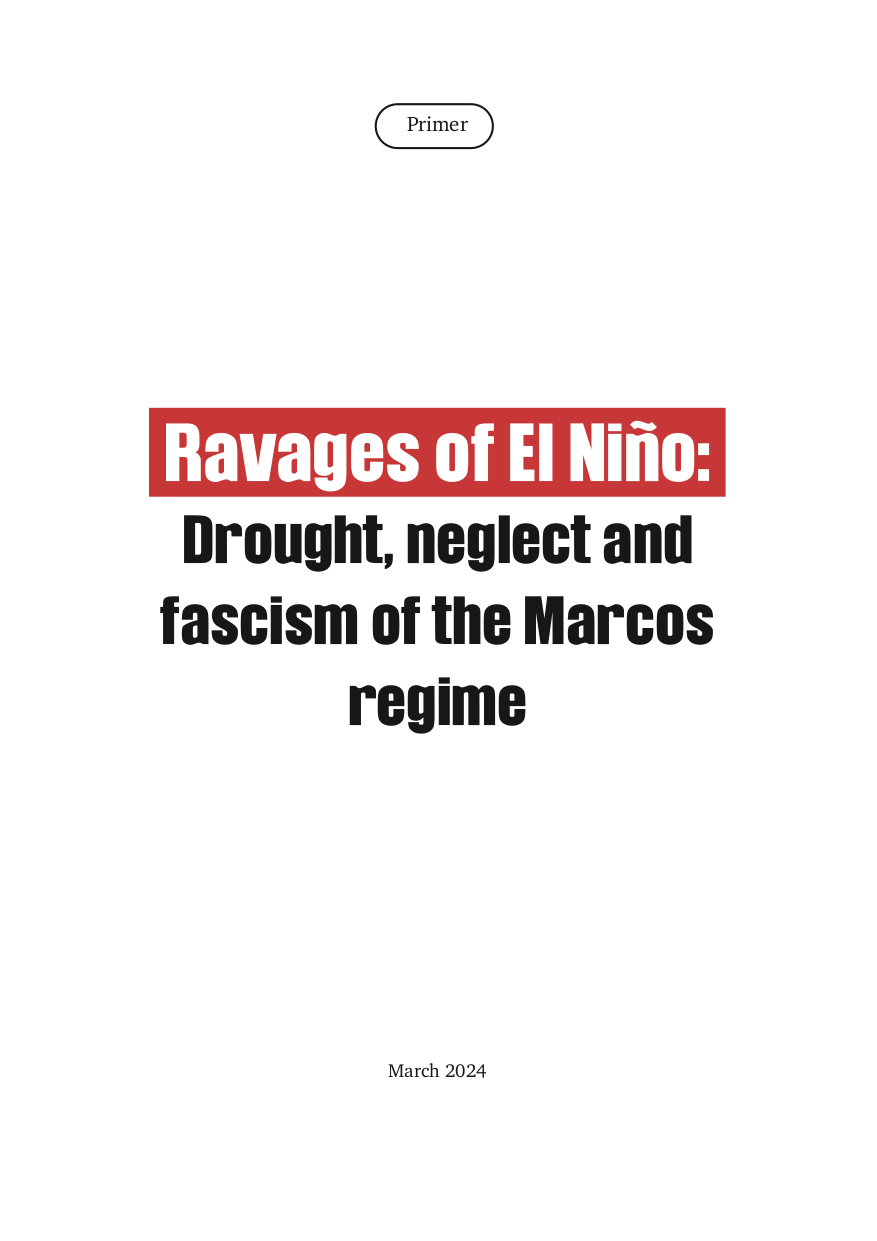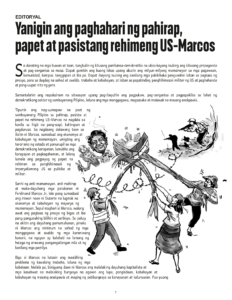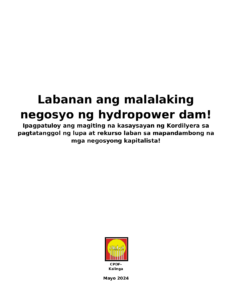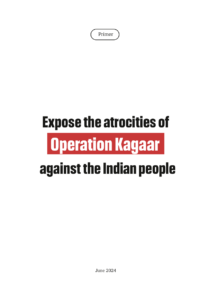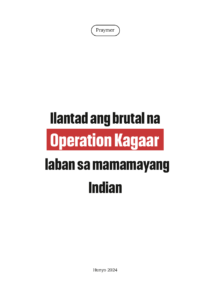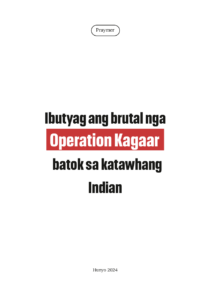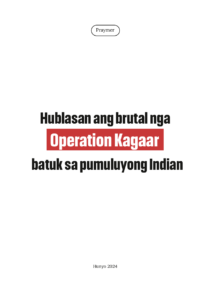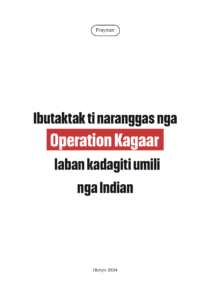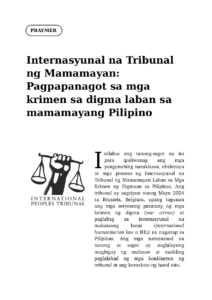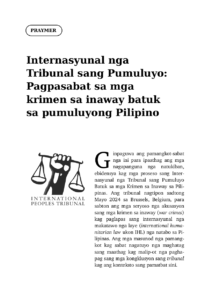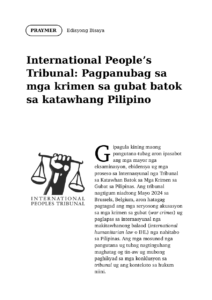(Primer) Ravages of El Niño: Drought, neglect and fascism of the Marcos regime
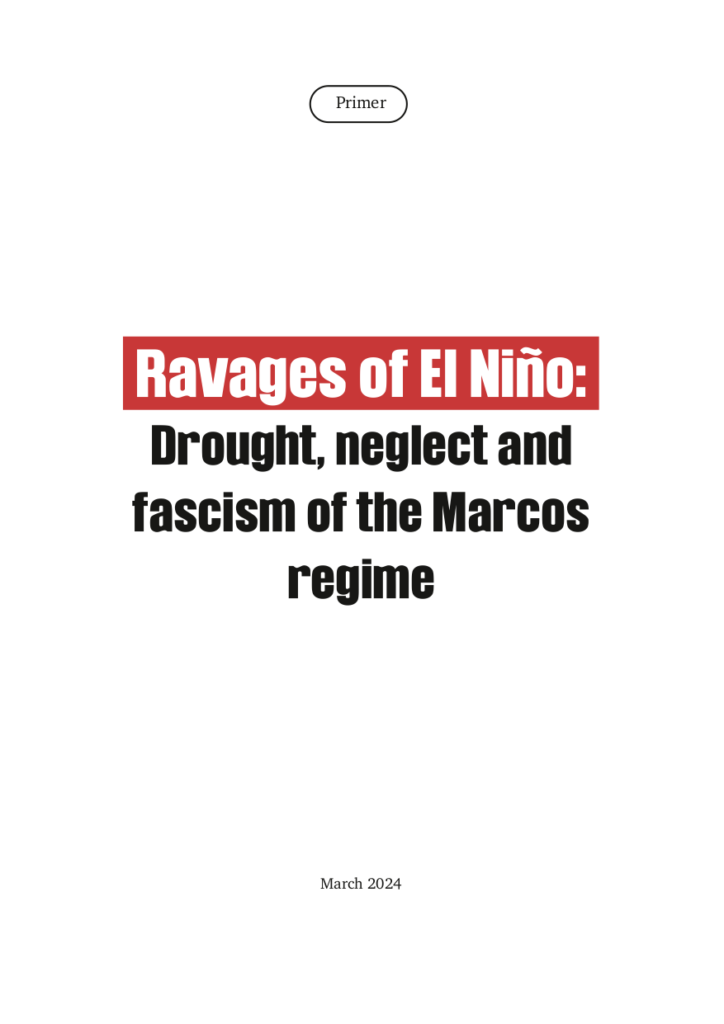
Introduction
Officials announced this March that El Niño has started to weaken in the country and around the world. However, this does not mean the masses of Filipino farmers and Filipino are now free from damage and burdesome impact caused by the drought. In fact, it is expected to continue until May or June in different parts of the country.
Many farms remain without irrigation resulting in the withering and complete destruction of crops. Many domestic animals can no longer be grazed because grass fields have dried up while others die due to extreme heat. Cases of cough, cold, fever and other diseases have also spread due to the lack of clean potable water.
Amid all this, the US-Marcos regime’s response to farmers’ grievances has been snail-paced and almost meaningless. The draft of his government’s purported “comprehensive” plan to deal came out only in January. Aside from being already late, it even installed the Department of National Defense Secretary Gilberto Teodoro as head of the “Task Force El Niño”.
Instead of relief and support, it has imposed a further burden of intensified military operations, raining bombs and bullets and fascist devastation in the countryside. These operations were spurred by Marcos’ renewed order to the Armed Forces of the Philippines (AFP) to “defeat” NPA units in the guerilla fronts by the end of March, all “vertical units” of the army by the end of June, and the revolutionary infrastructure in the countryside by the end of 2024. It has dropped scores of bombs, artillery shells and fired thousands of rounds against impoverished farming communities.
In this regard, the Information Bureau of the Communist Party of the Philippines is releasing this primer discussing the El Niño climate phenomenon, its effects on the Filipino masses and the accountability of the US-Marcos regime and its cohorts in neglecting the well-being of the people.
1. What is El Niño?
El Niño is a climate pattern that see abnormal or excessive warming of the ocean surface in the central and eastern parts of the Pacific Ocean. It usually occurs every two to seven years, and lasts nine to 12 months. El Niño influences the weather and formation of storms in different parts of the world. This happens in the context and framework of climate change caused by human activities.
The effects of El Niño vary in different regions of the world. One may experience extreme drought or extreme rainfall in different parts of the world.
El Niño’s frequent effects on regions
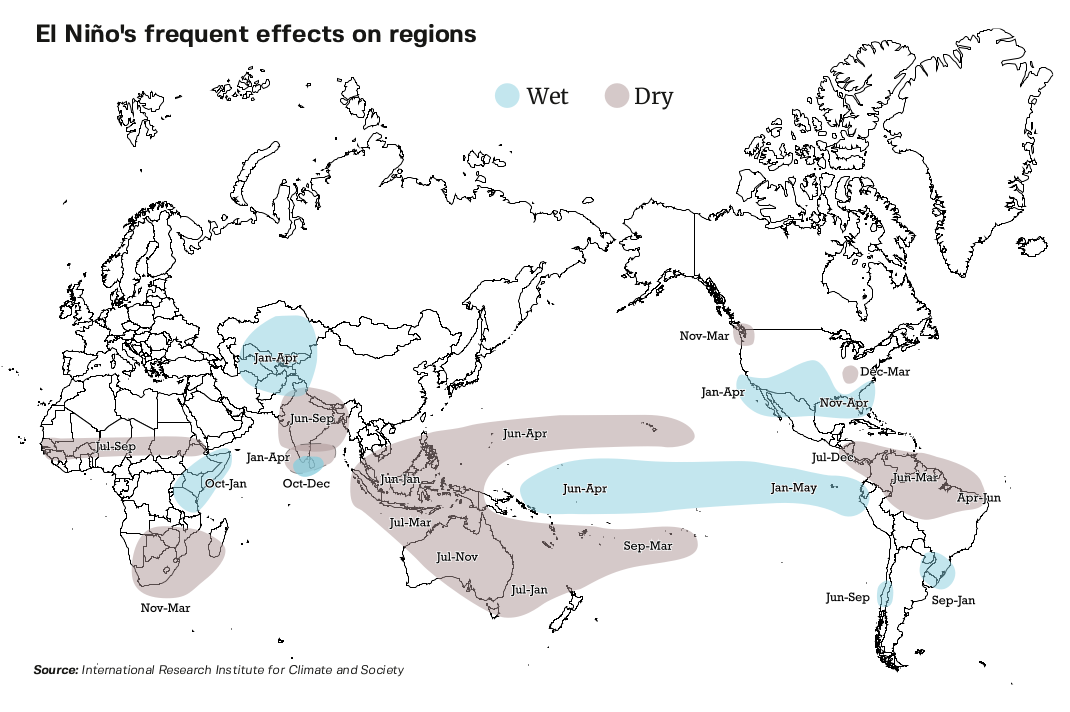
Since 1900, least 30 El Niños have occurred worldwide. El Niño was recorded as the worst in history in 1982-1983, 1997-1998 and 2014-2016. El Niño 2023-2024 is now among the five most intense in history.
El Niño 2023-2024
The World Meteorological Organization declared El Niño 2023-2024 to have started on July 4, 2023. Its effects were expected to be strongest between November 2023 and January 2024 before gradually weakening. However, it will continue to affect the global climate in the coming months which will intensify the heat trapped by greenhouse gas in the atmosphere. El Niño 2023-2024 is among the reasons why 2023 was recorded as the warmest year on record. It is expected to bring higher temperatures this March to May-June.
2. Impact on the Philippines
Drought is a common effect of El Niño in the Philippines. The Philippines is among the worst affected by climate change. El Niño is now ravaging 67 provinces in eight regions in the country. It will affect an estimated 70-76 provinces in the next three months. Thirty (30) of these provinces are now suffering from drought.
Drought gravely affects farmers and food production in the country. In the conservative record of the Department of Agriculture on March 18, damage to agriculture in eight regions has already reached ₱1.75 billion. Drought has already affected more than 32,000 hectares of plantations.
Damage was greatest in rice fields (₱1.1 billion in 18,000 hectares) followed by corn (₱317 million in 11,000 hectares). An estimated 48,332 metric tons of rice and 18,966 metric tons of corn were damaged.
Region IV-B (Mimaropa) has been most affected, followed by Western Visayas, Cagayan Valley, Central Luzon, Ilocos, Zamboanga peninsula, Region IV-A (Calabarzon) and Region XII (Soccsksargen).
Affected regions and damage to agriculture
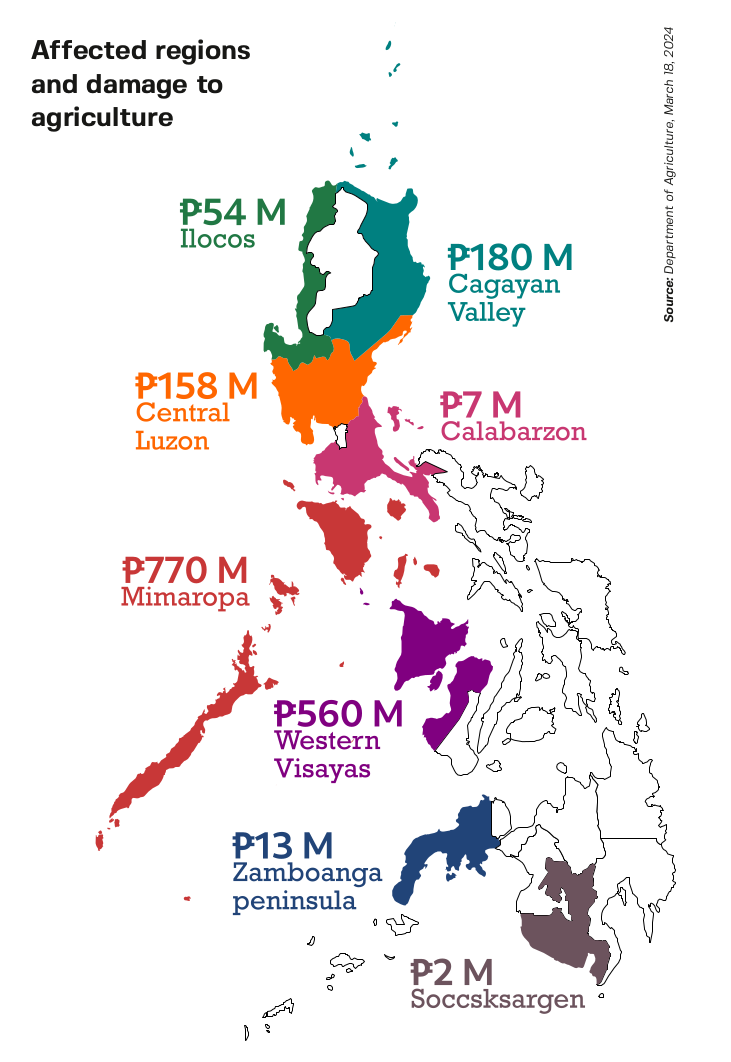
A state of calamity has been declared in seven towns throughout the Philippines due to the drought. These include Bulalacao and Mansalay in Oriental Mindoro; Looc, Magsaysay, and San Jose in Occidental Mindoro; Zamboanga City in Zamboanga del Sur; and Pio Duran in Albay.
Many health problems for farmers and their families became prominent due to El Niño. In Central Visayas alone, 6,000 El Niño-related illnesses were recorded in February.
Imperialist destruction of environment
In recent years, imperialist plunder in the Philippines has intensified the effects of El Niño and other calamities that hit the country. Foreign companies and bourgeois-compradors, big landlord and bureaucrat-capitalist partners are involved in plunderous mining, destructive plantations, large dams and other projects that destroy mountains and forests.
The country’s forest cover has fallen to 7 million hectares, equivalent to 23.3% of its total land area. This is considered hazardous to the environment. Logging operations allowed by the reactionary government have shrunk the country’s forests since the 1970s.
Meanwhile, over half of the country’s 14.2 million hectares of critical watersheds are considered unprotected under the reactionary law. An estimated 6.8 million hectares are vulnerable to deforestation, biodiversity loss, erosion, flooding, landslides and water pollution.
Mining operations that plunder Philippine mountains continue to expand. There are 56 mines (33 nickel, 12 gold, 4 chromite, 4 iron, 3 copper) in the country and seven processing plants all producing exclusively for export. In the first three quarters of 2023, the value of minerals extracted from these grew by 7.28% to ₱189.9 billion.
The Caraga region remains the largest mining area, followed by Region IV-B and Cagayan Valley. In Caraga, there are two gold mines, one chromite, 18 nickel, one hydrometallurgical processing plant, and one gold processing plant. The government is set to open 12 more mining projects in the first half of 2024.
3) Negligence by the reactionary state
El Niño is not new to the Philippines, but the reactionary state seems to have learned nothing from past experiences.
- During El Niño 1997-1998, more than ₱5 billion were recorded lost in agricultural production covering over 600,000 hectares of farmland.
- During El Niño 2014-2016, significant losses in agriculture were also experienced reaching ₱15.2 billion damaging 500,000 hectares in 57 provinces and two cities.
- In 2019, agricultural damage reached ₱7.96 billion devastating an estimated 247,610 farmers and fishermen from various parts of the country.
Although the country experiences El Niño cyclically, the state has made no significant preparations and implement only cosmetic projects. On many instances, politicians use the calamity as milking cow making money from kickbacks and corruption. Its damages are more intensified due to the backwardness of agriculture, and the basic problem of the landlessness of the peasant masses in the country.
El Niño highlighted the issue of lack of irrigation in large chunks of the country’s farms and rehabilitation projects for those that already stand. Due to very limited irrigation facilities, farmers are often left with barren lands.
In the conservative data of the NIA in 2022, it provided irrigation services to only 67.5% (or 2.11 million hectares of the target of 3.13 million hectares) despite the large amounts of funds allocated to it. In fact, the total amount of land to be irrigated in the country is possibly even greater.
From 2016 to 2022, irrigation expanded annually by a mere 2.5% or 39,300 hectares. At this rate, it will take 25 years to reach its 100% target level of irrigation. From this data alone, local food production is clearly not a priority of the NIA and the state.
In addition, irrigation is also affected by land use conversion which blocks natural waterways and natural canal irrigation. Irrigation is also damaged by the destruction of mountains and forests caused by imperialist plunder. The 14.2 million hectares of watershed area is critical to the national irrigation system and must be protected.
Giant dam, not for irrigation
Irrigation services is the usual pretext of the state to justify the construction of giant dams. But in truth, collected water is allocated for commercial use such as supply for privatized water distributors, and private companies in the industry and electricity services such as hydroelectric power generation. There are currently 15 large dams in the country.
Data from the Philippine Statistics Authority (PSA) covering 2010 to 2022 show that the share of irrigation in water use decreased from 81% to 75%, while that for industry increased from 10% to 15%, and for services from 9% to 10%. The volume of water for agriculture did not grow either (67.8 to 67.9 BCM or billion cubic meters), while that for electricity grew by 22% (110.8 to 135 BCM) and potable water for distribution by 117% (1.2 to 2.7 BCM).
Incompetence of the US-Marcos regime
For months, the DA has made announcements regarding the rapidly spreading drought, but the action take by the reactionary state is very negligible save for media statements on aid, relief, cloud seeding, irrigation repairs and calls to conserve water. Allegedly, ₱30 billion was allocated, but a large part of it was allocated to rice importation. Ensuring the livelihood of the peasant masses is not a priority of the Marcos regime.
The regime announced plans for mobilizing its agencies purportedly to respond to El Niño in April 2023, May 2023 and again on December 2023. They made no progress, and the response to El Niño only began when Executive Order No. 53 on January 19, half a year after its commencement was declared. To head the Task Force El Niño, the regime appointed Gilbert Teodoro, secretary of the Department of National Defense, a department far removed from environment or agricultural concerns.
The US-Marcos regime even announced in December 2023 that its priority measure is to ensure irrigation for farmers during the ravages of El Niño 2023-2024. It also promised to build “solar-powered irrigation units” for rain-dependent farms, projects funded by foreigners and local bureaucrats, including the Marcos family in Ilocos Norte.
The regime also allocated a meager amount of ₱5,000 each for aid and subsidy to the 2.3 million farmers who will be affected by the disaster. It also flaunted the limited ₱25,000 loan and ₱20,000 “insurance” that each affected farmer or fisherman can avail. It also allocated funds for responding to “climate change” which does not directly help the masses of farmers in their immediate needs. It also treacherously financed the importation of rice.
Even worse, Marcos now uses El Niño to allocate large funds to earn kickbacks in projects and programs.
Loss due to lack of irrigation
Marcos’ promises in Bulalacao and Mansalay, Oriental Mindoro went unfulfilled, lack of rain affects rice fields and onion crops and rivers that supply the farms dry up. Zero irrigation damaged crops and farmers lost. They are now deeper in debt more so because production costs are steep.
Farmers’ productions costs have doubled, and in some cases tripled, mainly in their desperate attempt to save crops by renting water pumps. The solar-powered irrigations that the DA boasts about, even the drought-resilient seeds that it distributes have hardly benefited the farmers, because basically, the fields are not irrigated.
Even when Bohol is not listed among those severely affected by the drought, farmers fear its impact on their farms. Tatay Boying is one of them. “Irrigation is difficult because we only depend on rain…others have irrigation, but only a few people benefit, then there is even favoritism,” he said.
Tatay Boying complains he already earns nothing from regular farming, and he will further lose because there is insufficient irrigation.
His total expenses for each planting cycle is at least ₱11,000. He harvested 456 kilos or 12 sacks of palay, two of which will go the landlord for rent. If he sells it, he will get only ₱9,120 with palay farmgate prices at ₱24 per kilo. Because of the heavy loss, and with skyrocketing rice prices in the market, Tatay Boying chose to no longer sell his crop.
Rain of bullets and bombs
Instead of raining water on the countryside, the US-Marcos regime rains bullets and bombs. Amid the El Niño disaster, the regime has carried out relentless and intensified combat operations of the military, its paramilitary forces and the police after declaring a new deadline to completely defeat the revolutionary movement in the countryside by the end of 2024.
The AFP is desperately trying to “end” the armed revolution to further pave the way for destructive imperialist and foreign mining, plantations and other destructive projects. These projects are driven by multinational companies, which are primarily accountable for the destruction of the Philippines’ environment and ecosystem.
In the past three months, cases of aerial bombing and shelling have been recorded in Abra, Quezon, Camarines Sur, Negros Occidental, Iloilo and Bukidnon. There have also been several cases of 500-lb bombs falling near farms and civilian communities. In addition, communities are garrisoned and prevented from making a living on their farms or entering the forest to find alternative livelihoods. The peasant masses in the countryside are being starved to death.
In the island of Negros alone, at least 70 cases of human rights violations have been recorded since January. This is equivalent to almost one case per day. Amid their suffering, the AFP squanders hundreds of millions of pesos in its widespread and successive operations.
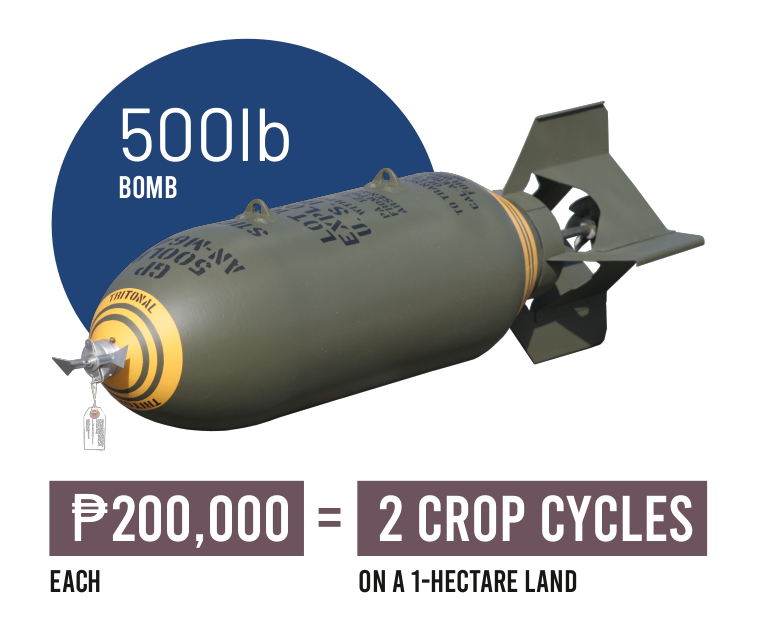
4. Collective resistance of the peasant masses
Facing the US-Marcos regime’s incompetence, the peasant masses possess all grounds to charge it with corruption, negligence and for pursuing policies that further impoverish them. They must demand the necessary measures for their immediate relief, including the distribution of necessary aid funds or emergency support, deferment or cancellation of debt payments, non-payment of land rent, and implementation of urgent solutions to solve the water problem.
At the same time, they should hold the reactionary state responsible for colluding with imperialist mining companies, plantations and energy plants that plundered and destroyed the forest causing severe impacts of climate change in the country.
In the face of this, farmers must come together to revive the spirit of cooperation to cope with the severe hardship brought by the drought. Through their organizations, they can plan mass mobilizations to coordinate efforts to maintain irrigation systems in their respective areas, and share the water in their fields. At the same time, farmers must call for real land reform as a lasting solution to their suffering.
The masses link arms to confront El Niño
In Negros Occidental, farmers’ organizations are planning coordinated and level-by-level mass campaigns to address El Niño. They started consultations, meetings and study campaigns at the barangay level, and they aim to extend it to town and district levels.
They prepared a petition stating their call for the government to provide adequate aid, food and subsidies for their production. They insist that if they will not be provided with enough assistance, they are ready to collectively act for a dialogue and confrontation with local agencies.
Meanwhile, to support production, farmers revived dagyaw-alayon, the traditional form of agricultural cooperation in the region.
In the southern part of Negros Occidental, they set to communally cultivate an area of land they acquired through a successful campaign. They agreed to plant corn on the land. “This is the primary aspect of the cooperation…we follow the framework of “work points,” shared the participating farmer. They agreed that the women’s group will water the corn fields nightly.
Their unity and alliance work with the middle forces in the community also bore fruit. They said the hoses they got as support were a big help. They use this for irrigation especially with distant water sources.
History has also proven that the farmers are ready to act collectively if the state does not listen to their hunger pangs.
2016: Farmers’ barricade in Kidapawan
In 2016, six thousand farmers from different provinces in Mindanao barricaded the highway and major roads of Kidapawan City, North Cotabato from March 30 to April 1 to demand from the local government 5,000 sacks of rice in aid to confront famine due to El Niño. They also called for seeds, fertilizers and pesticides for their crops. The province has been under a state of calamity since January 2016.
After several dialogues between the farmer-leaders and the provincial governor, those who barricaded were only insulted with offers of 3 kilos of rice each. Instead of addressing their grievances, state forces attacked them and opened fire on them. Three farmers were killed and more than 100 were injured.
The Kidapawan Massacre that took place became a prominent issue in the country and bonded many groups to unite and deliver help and aid to the farmers. Sacks of rice came to them from private groups and individuals, following the exposure of the incompetence of the then US-Aquino II regime in responding to the disaster caused by El Niño.
In the face of further escalating El Niño disasters in many provinces, the peasant masses must collectively charge the US-Marcos regime. His negligence and fascist attacks inflame the anger of the peasant masses and drive them to the path of protest and resistance.
______
Prepared by:
Information Bureau
Communist Party of the Philippines
March 2024

